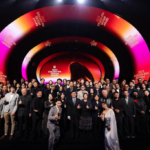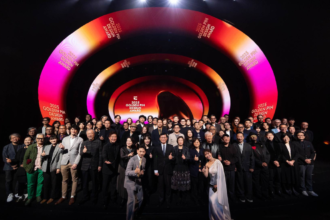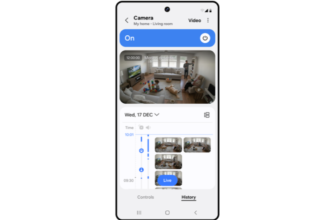1. Let’s go back to the beginning. You broke into the US tech video market while still a university student. What sparked your interest in storytelling/marketing for tech, and what gave you the confidence to go after such a competitive space?
What first sparked my interest in storytelling was really the early YouTube wave when I was a teenager. I was fascinated by how individuals could build an audience and shape culture just by sharing stories through video.
By the time I was in university, I was already running my own agency, making all kinds of videos for B2C clients. There wasn’t much of a niche back then; we did everything from corporate anniversary films for Keppel and M1 to influencer campaigns for IUIGA. It was a great learning ground, but I knew I wanted to go deeper into work that felt more meaningful and intellectually engaging.
That chance came when I joined NUS’s NOC program, which sent me to Toronto for a year. It wasn’t easy, I had to slow things down at the agency, even managing an ongoing SBS Transit project remotely, but the exposure was eye-opening. I started meeting founders, engineers, and marketers at networking events, and I noticed something: everyone was trying to explain their product verbally in crowded rooms, yet it felt too forced to pull out a pitch deck.
That’s when it clicked. There was a real gap for something that could tell their story quickly, clearly, and visually, something that felt smart but human. A one-minute video that could convey the problem, the tech, and the experience better than any deck could.
That realization was the start of everything. I took what I’d learned from years of production and applied it to a new space, helping tech companies translate complex ideas into crafted, accessible stories. That’s really how VideoPulse was born.
2. Singapore’s creative scene often feels hyper-local. You’ve said before that creatives here tend to “sell to each other.” Why do you think that mindset persists, and how did you personally challenge it?
I think it’s natural, people want to work with people they know. In Singapore, that comes from our more collectivist culture, where relationships and familiarity carry a lot of weight. It’s not a bad thing, but the downside is that sometimes the metric becomes who you know rather than how good you are.
I’ve seen a lot of creatives focus on networking or “social hacking” their way through, and while that has its place, it can also make people overlook the craft itself. For me, I’ve always believed both are needed, you have to build genuine relationships, but your work should speak strongly enough that it travels beyond your circle.
3. VideoPulse works with global clients like DocuSign, yet your operations are anchored in Southeast Asia. Tell us how you designed that model, and what made it work across such different time zones and expectations.
Our project managers are based in New York, while our animation and creative teams are spread across Southeast Asia and LATAM. It’s a distributed setup, but it works because everything is planned with precision.
A big part of our success has been scheduling revision timelines well in advance. We plan internal reviews and client reviews more than a month ahead, so everyone knows exactly when feedback is due. We don’t rush to finish a draft at the last minute or scramble to gather people across time zones for a quick review. Instead, we stay aligned, and even if revisions are ready early, we still meet on the pre-set date to maintain consistency and structure.
We also follow a few principles that keep the team healthy and productive, like no weekend work. In the creative world, it’s easy to fall into the “just a quick 30-minute edit” trap, which often turns into scope creep. We’ve learned to respect time, both ours and the client’s, and that’s helped us maintain quality, trust, and long-term working relationships.
4. You created the PAC framework (Purpose, Audience, Content) to help clients get clearer about what they really need from video. What are some common misconceptions companies have about storytelling, and how does your framework help cut through that noise?
The biggest thing about the PAC framework is that it helps people think on a deeper and more specific level. For example, in a video we did for Factorem, a Block71 company, we identified that one of their key purposes was to remind users that they aren’t a marketplace, but an enabler for faster sourcing of parts in production. They also wanted to focus on US leads, which guided us to feature US-centric brands as examples.
The framework makes you question even the subtle reasons a company wants a video. Sometimes it’s not just about marketing – it could be about perception. For instance, maybe they feel customers see them as too expensive, so we might go for a slightly more approachable or down-to-earth tone in the visuals, even if the production cost isn’t lower.
The biggest misconception about storytelling is that people see it only as a three-act structure – problem, climax, and resolution. While that matters, storytelling in marketing is often simpler and more emotional. It’s about asking, “What do we want the audience to feel, and what do we want them to do as a result?”
5. One part of your story that stands out is your willingness to ‘code switch’, from language to cultural tone. How important is that in building trust with Western clients, especially when you’re running a team based in Asia?
Very insightful question, it actually plays a huge part. I think it’s less about mimicking an accent or using Western slang, and more about showing that I get their cultural references and rhythm.
We’re often behind the scripting process, and that’s where cultural fluency really matters. The right metaphor or phrasing can completely change how an audience connects. For instance, in Singapore we might say “Grab for X” and everyone instantly gets the idea. In the US, there are equivalent shorthand phrases that carry that same familiarity, and understanding those nuances gives clients confidence that we truly understand how their customers think and how their tone will be received.
6. What are some things you’ve learned about running remote creative teams that you wish more leaders would understand? Has your experience managing across continents taught you anything unexpected?
Documentation is key. Record every meeting, but more importantly, write things down as the discussion happens. We use AI note-takers too, and they’re great, but there’s a difference when you, as the leader, are deliberately writing notes, framing thoughts, and capturing what’s important in real time.
When your team sees that you’re writing during a review or brainstorm and you later send those notes manually in the group chat, it carries more weight. It shows intention, that you were thinking alongside them, not just letting automation summarize it.
Another thing I’ve learned is to always check in personally. It’s not all about work. After every project, I take time to ask freelancers and team members how things went, what worked, what didn’t, and I ask them honestly without the project manager present. You get a very different kind of feedback that way.
Whenever I can, I also meet people physically. I recently visited New York for a client project and made it a point to meet our project managers in person and watch our DocuSign videos live at the event. That sense of tangibility, seeing your work in the real world together, builds a different kind of connection.
I’m hoping to do the same soon with our collaborators in LATAM too.
7. Singaporean creatives are often described as precise, structured, and efficient, but sometimes not seen as “bold” or “visionary.” Do you think that’s fair? How have you worked to change that perception through your work?
To be frank, I think there’s some truth to that, but I actually see it as an advantage. My US clients often appreciate that when we come into a first meeting, there’s already a clear process document, timelines mapped out, and forethought in place. Even during revisions, we plan ahead and keep agendas tight, that structure gives clients confidence.
I think we should keep how we work, but be bolder in what we try. Our strength in being analytical and process-oriented can actually give us the safety net to experiment. When you know your boundaries, you can take calculated creative risks.
For example, my team and I recently made a vlog covering the Cursor Hackathon, Singapore’s largest. It was completely outside our usual scope, but still aligned with our tech audience. That video ended up featured on The Straits Times, hit 15K views on Instagram, and even got a collaboration post with WakeupSG. It wasn’t a huge production, no fancy animation, no storyboard, just a quick experiment to test a new style.
We treat these as structured experiments. We might do three of them, track the outcomes, and learn what works. In parallel, we’re creating short-form videos about distribution in the tech industry, again with the same mindset: small bets, clear boundaries, and consistent iteration. That’s how I think Singaporean creatives can stay precise and efficient while still pushing for bold, original work.
8. What’s one unpopular opinion you have about the digital marketing industry that more people need to hear?
One unpopular opinion I have is that not every piece of content needs to look unpolished to perform well. Somewhere along the way, people started believing that if it’s quick, meme-based, or raw, it’s automatically more authentic or viral. TikTok really fueled that mindset because a few scrappy videos took off, and many brands assumed that style could just be replicated. But that’s lazy thinking.
There are two ways to relook at it.
First, even unpolished content needs taste. Applying a trend tastefully and in your own context still requires an understanding of tone, timing, and emotion. Authentic doesn’t mean random, it’s about intention behind simplicity.
Second, it’s absolutely possible to be polished and viral. For example, companies like Duolingo and Notion have pulled this off perfectly, their content is clean, well-produced, but still playful and human. The production value doesn’t kill the relatability, it amplifies it.
The truth is, good storytelling will always outperform trends. Whether polished or scrappy, it’s the thought, taste, and intent that make something resonate.
9. The creative economy here is growing, but global exports still lag.
From your experience, what would it take to turn Singapore into a true hub for international creative leadership, not just execution?
This is an interesting question because, although we’re collectivist as a culture, we often think in ways that aren’t “market level.” We still see ourselves too much as individuals rather than as part of a larger creative ecosystem.
What I mean is, in more mature creative markets, people view their careers and work as part of a broader statistical process where your cumulative experiences, experiments, and risks all contribute to the market evolving.
Take ClickUp for example, a US SaaS company for collaboration. They started doing comedy skits about office life as part of their organic growth efforts. It was unique, spoke directly to their audience, and had viral potential. That kind of creative experiment likely came after many other small, failed attempts, and that’s normal.
In Singapore, because we’re highly meritocratic, we tend to tie our value to achievement and timelines. There’s a sense that by a certain number of years in, you should have reached a particular milestone or client base. As a result, we don’t always view creativity as something transient, iterative, or experimental. We think what we start with has to work, so we default to proven formulas or copy styles that have worked elsewhere.
But real creative leadership comes from experimentation and persistence, the same way startup culture celebrates iteration. No one says a founder failed because their first two companies didn’t take off, they see it as part of the process that led to the third one succeeding. If we could adopt that same mindset in the creative space, Singapore could evolve from being an executor to a genuine hub for creative innovation.
10. Finally, what advice would you give to younger creatives who want to go global, but feel boxed in by local expectations? Is it about mindset, skill, networks, or something else entirely?
Don’t go global for the sake of it. Start by figuring out what you actually enjoy doing, and who you enjoy serving, quite literally.
When I first started, I said yes to everything. I made real estate videos, snack commercials, corporate anniversary films, you name it. Over time, I realized I didn’t enjoy being on production sets all the time, and I didn’t like working with overly corporate clients or real estate types. But I discovered I liked motion graphics, something I first explored during my live production days, and I enjoyed working with startup founders. They were curious, passionate, and open to creative ideas. It just so happened that there was more demand for that kind of storytelling overseas, so that’s where I focused.
If you’re clear on what drives you, going global becomes a natural extension of that focus. From there, I’d suggest three things:
- Join paid online communities. People take each other more seriously there, and the members usually have budgets. For example, if you want to create videos for tech devices, join a paid community of tech enthusiasts or makers.
- Network in person. Take one flight. It costs money, yes, but with a well-planned trip during summer or autumn, when most major events happen in the States, you can line up back-to-back meetups. Build real friendships and keep in touch genuinely. Opportunities will follow.
- Post on LinkedIn. I had my own hesitation about this, but here’s the insight: if a post doesn’t do well, no one sees it anyway. And if it does, then it’s already worth it. Either way, you learn, you build consistency, and people start to associate your name with your craft.
Going global isn’t about escaping your local scene, it’s about expanding your circle of people who value what you uniquely bring.
Legal Disclaimer: The Editor provides this news content "as is," without any warranty of any kind. We disclaim all responsibility and liability for the accuracy, content, images, videos, licenses, completeness, legality, or reliability of the information contained in this article. For any complaints or copyright concerns regarding this article, please contact the author mentioned above.















